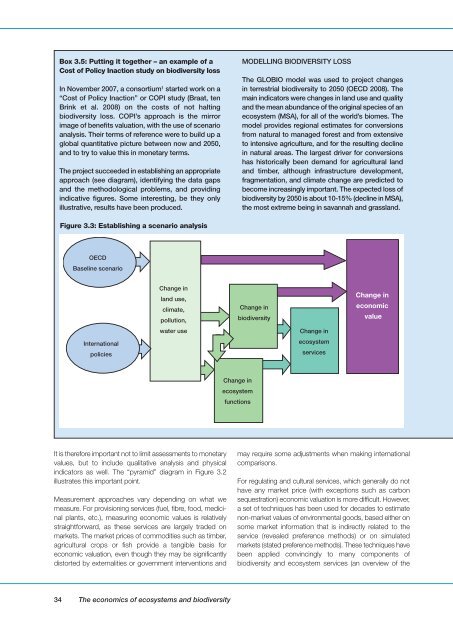Interim Report - TEEB
Interim Report - TEEB
Interim Report - TEEB
Create successful ePaper yourself
Turn your PDF publications into a flip-book with our unique Google optimized e-Paper software.
Box 3.5: Putting it together – an example of a<br />
Cost of Policy Inaction study on biodiversity loss<br />
In November 2007, a consortium 1 started work on a<br />
“Cost of Policy Inaction” or COPI study (Braat, ten<br />
Brink et al. 2008) on the costs of not halting<br />
biodiversity loss. COPI’s approach is the mirror<br />
image of benefits valuation, with the use of scenario<br />
analysis. Their terms of reference were to build up a<br />
global quantitative picture between now and 2050,<br />
and to try to value this in monetary terms.<br />
The project succeeded in establishing an appropriate<br />
approach (see diagram), identifying the data gaps<br />
and the methodological problems, and providing<br />
indicative figures. Some interesting, be they only<br />
illustrative, results have been produced.<br />
MODELLING BIODIVERSITY LOSS<br />
The GLOBIO model was used to project changes<br />
in terrestrial biodiversity to 2050 (OECD 2008). The<br />
main indicators were changes in land use and quality<br />
and the mean abundance of the original species of an<br />
ecosystem (MSA), for all of the world’s biomes. The<br />
model provides regional estimates for conversions<br />
from natural to managed forest and from extensive<br />
to intensive agriculture, and for the resulting decline<br />
in natural areas. The largest driver for conversions<br />
has historically been demand for agricultural land<br />
and timber, although infrastructure development,<br />
fragmentation, and climate change are predicted to<br />
become increasingly important. The expected loss of<br />
biodiversity by 2050 is about 10-15% (decline in MSA),<br />
the most extreme being in savannah and grassland.<br />
Figure 3.3: Establishing a scenario analysis<br />
OECD<br />
Baseline scenario<br />
International<br />
policies<br />
Change in<br />
land use,<br />
climate,<br />
pollution,<br />
water use<br />
Change in<br />
biodiversity<br />
Change in<br />
ecosystem<br />
services<br />
Change in<br />
economic<br />
value<br />
Change in<br />
ecosystem<br />
functions<br />
It is therefore important not to limit assessments to monetary<br />
values, but to include qualitative analysis and physical<br />
indicators as well. The “pyramid” diagram in Figure 3.2<br />
illustrates this important point.<br />
Measurement approaches vary depending on what we<br />
measure. For provisioning services (fuel, fibre, food, medicinal<br />
plants, etc.), measuring economic values is relatively<br />
straightforward, as these services are largely traded on<br />
markets. The market prices of commodities such as timber,<br />
agricultural crops or fish provide a tangible basis for<br />
economic valuation, even though they may be significantly<br />
distorted by externalities or government interventions and<br />
may require some adjustments when making international<br />
comparisons.<br />
For regulating and cultural services, which generally do not<br />
have any market price (with exceptions such as carbon<br />
sequestration) economic valuation is more difficult. However,<br />
a set of techniques has been used for decades to estimate<br />
non-market values of environmental goods, based either on<br />
some market information that is indirectly related to the<br />
service (revealed preference methods) or on simulated<br />
markets (stated preference methods). These techniques have<br />
been applied convincingly to many components of<br />
biodiversity and ecosystem services (an overview of the<br />
34 The economics of ecosystems and biodiversity

















